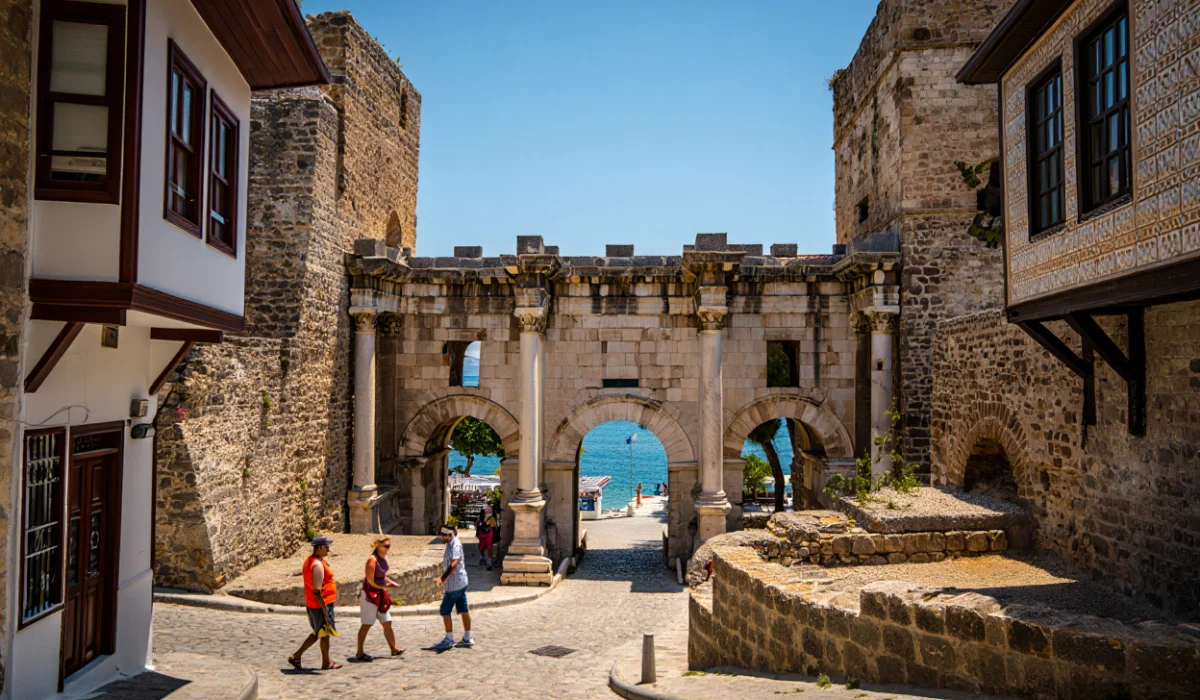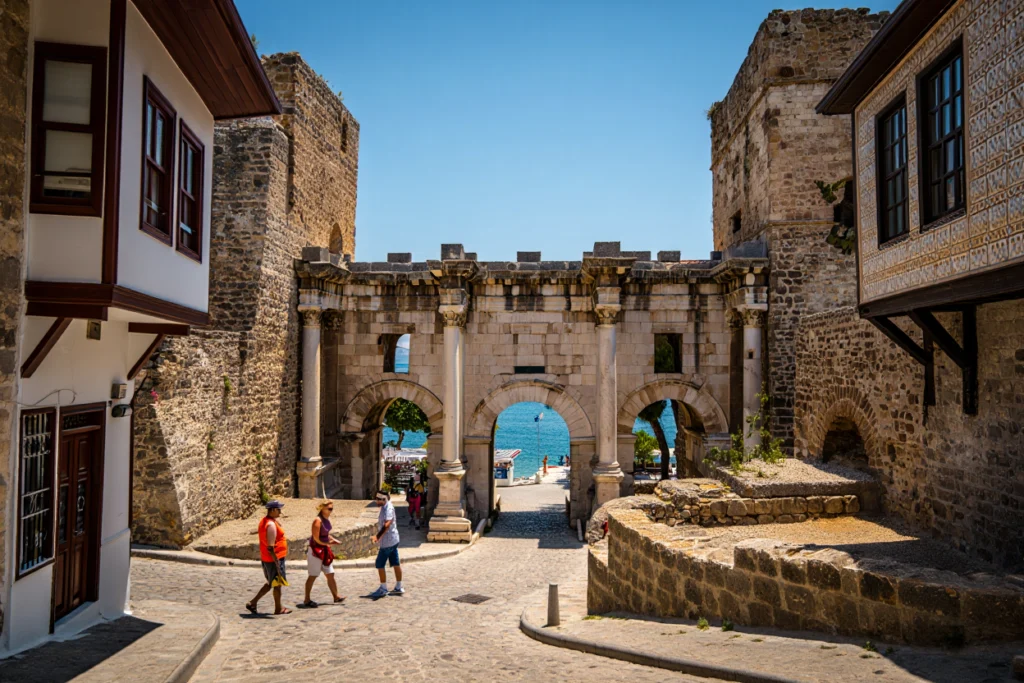

Antalya, often called the “Pearl of the Mediterranean,” is not only famous for its golden beaches and turquoise waters but also for its remarkable historical and cultural sites. This coastal city in southern Turkey offers a unique blend of ancient civilizations, vibrant local life, and modern amenities. In this post, we will delve into Antalya’s top historical attractions and what you can look forward to experiencing when you visit.
1. Kaleiçi (Old Town)
Brief History
Kaleiçi, also known as the Old Town, is the heart and soul of Antalya. Its history traces back to the Roman era, and it has since been influenced by the Byzantine, Seljuk, and Ottoman civilizations. As you wander through the narrow cobblestone streets, you’ll find a mix of well-preserved Ottoman-era homes, souvenir shops, boutique hotels, and welcoming cafés.
What to Expect
- Charming Architecture: Admire the intricately carved wooden balconies and the traditional red-tiled roofs that reflect centuries of architectural evolution.
- Harbor Views: Stroll down to the historic harbor for stunning Mediterranean views. It’s an ideal spot for a sunset photo or a leisurely boat tour.
- Cafés and Restaurants: Savor fresh seafood or traditional Turkish dishes as you watch boats float gently on turquoise waters.
2. Hadrian’s Gate
Brief History
Built in honor of the Roman Emperor Hadrian’s visit in 130 AD, Hadrian’s Gate is one of the most iconic landmarks in Antalya. This imposing marble gate once served as the grand entrance to the city walls that protected Antalya for centuries.
What to Expect
- Impressive Architecture: Take a close look at the columns and decorative carvings—some of the finest examples of Roman stonework in Turkey.
- Historic Corridor: The gate leads directly into the lively streets of Kaleiçi, offering a natural transition from modern Antalya into the city’s ancient past.
- Vibrant Atmosphere: The surrounding area is always abuzz with locals, tourists, and street vendors, making it a perfect spot for people-watching.
3. Yivli Minaret (Fluted Minaret)
Brief History
Commissioned by the Seljuk Sultan Alaaddin Keykubad in the early 13th century, the Yivli Minaret is a symbol of Antalya and a prime example of Seljuk architecture. Its ribbed or “fluted” design lends it a distinctive silhouette.
What to Expect
- Historical Mosque Complex: The minaret is part of a larger religious complex that includes a functioning mosque and medrese (school).
- Panoramic Views: While you can’t climb the minaret itself, the surrounding area offers fantastic views of Antalya’s skyline.
- Cultural Insight: The complex provides a glimpse into the city’s Islamic heritage and its important role as a spiritual center.
4. Aspendos
Brief History
Located about 40 kilometers east of Antalya, the ancient city of Aspendos was founded by the Greeks and later flourished under Roman rule. Its well-preserved theater, constructed in the 2nd century AD, is celebrated for its exceptional acoustics and architectural brilliance.
What to Expect
- Magnificent Roman Theater: The theater can seat up to 15,000 spectators and is still used for concerts and festivals today.
- Roman Aqueduct: Take a short walk to explore the ruins of an impressive Roman aqueduct that once supplied water to the city.
- Cultural Performances: Check local schedules for performances of ballet, opera, or concerts in the theater—an unforgettable way to experience ancient history firsthand.
5. Perge
Brief History
Perge was an important city in the ancient region of Pamphylia, dating back to the Bronze Age. Over the centuries, it came under the influence of the Persians, Greeks, and Romans. Its expansive ruins provide a fascinating look into the city’s grandeur.
What to Expect
- Well-Preserved Stadium: Once hosting sporting events for up to 12,000 people, the stadium offers an immersive look into ancient sports culture.
- Grand Colonnaded Street: Marvel at the columns lining the main street, imagining the bustling markets of centuries past.
- Intricate Mosaics: Step into the Roman baths to see fine examples of mosaic art that highlight the region’s sophisticated lifestyle.
6. Termessos
Brief History
Nestled in the Taurus Mountains, Termessos is often called the “Eagle’s Nest” due to its high altitude and strategic location. Known for its independence, Termessos notably resisted Alexander the Great’s siege, preserving its unique culture and autonomy.
What to Expect
- Dramatic Mountain Setting: Enjoy panoramic views of Antalya’s rugged terrain as you explore the site’s theater, agora, and necropolis.
- Rich Flora and Fauna: The surrounding national park teems with diverse plants and wildlife, making it an excellent spot for nature enthusiasts.
- Less Crowded Adventure: Because it requires a bit more effort to reach, Termessos is often quieter than other sites—ideal for travelers seeking a tranquil and immersive historical experience.
Practical Tips for Tourists
- Best Time to Visit: Spring (April–June) and fall (September–November) offer comfortable weather for exploring ancient ruins without the intense summer heat.
- Guided Tours: Hiring a licensed guide or joining a tour can enrich your experience, providing deeper insights into each site’s history.
- Wear Comfortable Shoes: Ruins and cobblestone streets can be uneven. A sturdy pair of walking shoes will keep you comfortable.
- Stay Hydrated: Antalya’s climate can be hot, especially during summer. Always carry water and wear sunscreen.
Conclusion
Antalya is a treasure trove for history buffs and curious travelers alike. Whether you’re strolling through the ancient streets of Kaleiçi, marveling at the Roman engineering feats in Aspendos, or taking in the rugged beauty of Termessos, you’ll find countless stories waiting to be uncovered. This is a city where past and present coexist in harmony, offering a compelling reason to visit year-round.
If you’re planning a trip to Turkey’s Mediterranean coast, don’t miss the chance to delve into Antalya’s historical wonders. You’ll walk away with not only stunning photos but also a profound appreciation for the civilizations that shaped this captivating region.


